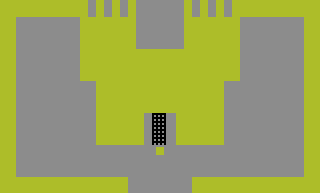 |
 |
What is the #1 Atari Game? |
 There is no denying the fun and excitement of this classic 2600 game. No game has been able to match the sense of wonder we all felt when we were first chased by the red dragon. No amount of Kool-Aid would calm us down when the bat stole the life-protecting sword. And nothing could ever match the feeling of accomplishment when the enchanted chalice was returned to it's rightful place in the gold castle.
There is no denying the fun and excitement of this classic 2600 game. No game has been able to match the sense of wonder we all felt when we were first chased by the red dragon. No amount of Kool-Aid would calm us down when the bat stole the life-protecting sword. And nothing could ever match the feeling of accomplishment when the enchanted chalice was returned to it's rightful place in the gold castle.
Adventure holds the distinction of being the first game with an Easter egg. Finding the invisible dot and slipping through the black barrier became an accomplishment for many an Atari player. Today, Easter eggs are a requirement of video games.
Thanks to the creativity and ingenuity of Warren Robinett, Adventure truly is a memorable game worthy of being the greatest Atari game of all time.
Version: 2600
Why Atari 2600 Adventure is such a fun game
by Warren Robinett
 First of all, let's not forget the game that directly inspired me --
the original text adventure game (also named "Adventure") which was created by Don Woods and Willie
Crowther. They invented the idea of moving from room to room, carrying objects that you could use to get past obstacles, and creatures
that moved around and did things in the game world. Their game was pure text -- the user typed text commands and
then received text descriptions of the room he or she was in, and the objects being carried.
First of all, let's not forget the game that directly inspired me --
the original text adventure game (also named "Adventure") which was created by Don Woods and Willie
Crowther. They invented the idea of moving from room to room, carrying objects that you could use to get past obstacles, and creatures
that moved around and did things in the game world. Their game was pure text -- the user typed text commands and
then received text descriptions of the room he or she was in, and the objects being carried.
My main breakthrough, I think, was figuring out how to do this kind of game -- rooms, objects and creatures -- in the video game medium -- with animation, color, sounds, and joystick controllers. There are 3 powerful ideas in this that were, at the time, different from how most video games were done.
Exploring a large space (in this case, the network of rooms).
Objects that the player could pick up and move around, and which functioned as tools to do things in the game world.
 Creatures which moved around on their own, initiating actions.
("AI's", in modern terminology) Putting these elements together in a video game produced what
we now call an action-adventure game, which has shown, over the last few decades, that it is a very fertile genre.
Creatures which moved around on their own, initiating actions.
("AI's", in modern terminology) Putting these elements together in a video game produced what
we now call an action-adventure game, which has shown, over the last few decades, that it is a very fertile genre.
At the time, game designers were trying to figure out what you
could do that was cool with this new medium of interactive computer graphics, so I think you could now say that I discovered
one of the "sweet spots" in the medium.
Of course, all the details were important -- what the objects and creatures
did, and what they looked like, how the game world was laid out,
how the controls worked. I dug out a list I made once for myself
of why I thought Adventure worked well. Here it is.
Game world good size (30 rooms, 8 regions). Closed -- can explore it all. Having regions (eg castle interior or catacombs). Regions can be (temporarily) inaccessible.
 Object permanence -- objects and creatures
are never created or destroyed. Each one is always somewhere in the game world.
Object permanence -- objects and creatures
are never created or destroyed. Each one is always somewhere in the game world.
No randomness during game-play. Algorithmically-generated complex behavior is more interesting and understandable than just generating a new monster every so often based on a random number generator.
Fairly consistent fantasy (Dungeons and Dragons).
Creatures (objects that moved around on their own, initiating actions). The creatures in the game were similar to animals in real life -- they move around, they do things, they have motivations which can be inferred from their behavior. Each creature had a subroutine that controlled what it did, which was executed 20 times per second. I came up with a data structure to represent a creature's goals -- a prioritized list of objects and whether to go toward or away from that object. The creature went down its priority list until it found an object on the list in the same room with it. Then it went towards the object, or away from. (I called this chasing and fleeing.) Each creature had its own priority list, and so had different behaviors. There were 4 creatures altogether -- three dragons and one bat. This was a pretty good scheme, because it modeled limited perception (couldn't "see" across room boundaries), and allowed a creature to "change its mind" when a new object came into the room.
Objects as tools to get past obstacles. Problem-solving. I chose not to have a timer in the game to emphasize exploration and problem-solving, which I felt would not be enhanced by arbitrary time limits.
You can win the game. In many video games at the time, you just kept playing until you finally got killed.
Mazes. The multi-screen, non-planar mazes were interesting. Having isolated parts that you needed the bridge to get to added further interest to the mazes.
Progressive difficulty levels. Level 1 was designed for beginners, and Levels 2 and 3 were harder. Flipping the difficulty switches made the dragons significantly more challenging.
Variety. Random object placement at the start of Level 3 (similar to shuffling the cards before a hand of bridge) gave it much more variety. The bat, which moved around objects, kept the game from being *too* predictable. It had enough variety to not be a pure puzzle, which can be solved the same way every time.
Grabbing objects. There was something simple and satisfying about grabbing objects and carrying them around. Allowing only one object to be carried at a time was a good decision. It simplified the user-interface. It meant the game could stay always in real-time (never going to an inventory screen). It created strategic choices (carry the weapon or the treasure?).
Simple, understandable story, theme, and goal. Good manual. Nice-looking box which conveys theme. (Well, the theme was a quest for the Holy Grail. But the Atari marketing department renamed the Holy Grail to be the Enchanted Chalice.)
Controls intuitive. I used the joystick for what it is best at -- moving an icon in 2D on the screen. The user interface for grabbing and dropping objects was very easy to learn and remember.
Object-object interaction was easy to understand. (example: sword killing dragon). These were triggered by overlap of object shapes (which were called "collisions"). This is like in the real world when two objects touch each other, they affect one another.
Restarting (re-incarnating) when killed. Simple and understandable. Leaving all the objects where they were was a good decision. This meant getting killed did not cause you to start over. But it did penalize you. Bringing all dead dragons back to life when the player re-incarnated was analogous to being vulnerable in the game of bridge. You have more to lose in some situations.
Sounds. The sounds were fairly good, given the hardware. They changed over time, which not all 2600 sound effects did. Tying short sound effects to game events was effective.
Square cursor and walls. Most games since Adventure have used a character as the user's avatar. An advantage to the square cursor is that it is easy to see when the cursor will run into a wall, and where the paths are. The visual feedback (jiggling cursor) when running into a wall was valuable. You could also slide along a wall when the joystick was attempting a diagonal movement. Since you spent most of your time moving through mazes, it was important to have this interaction smooth, intuitive, and glitch-free.
Some objects could not be picked up. (eg dragon carcass).
Jokes. Bat steals your sword. Bat carries dragon. (This always got a laugh the first time someone saw it.)
Bat and dragons could go through walls, but you have to follow the maze paths. Good balance since the player is actually smarter than the simple AI routines of the bat and dragons.
The secret room. Having a really hard-to-find secret place in the game, that was so secret it was secret even from Atari was kind of cool. It fueled a good rumor buzz. Maybe the kids could appreciate the programmer (little guy -- me) getting away with something (putting my signature in the game).
(I think I speak for all Atarians when I say, "Thanks Warren!")
| Name: | |
| Subject: | |
| Comment: | |
| Check: | What is the greatest video game company of all time? (Hint: Atari.) |